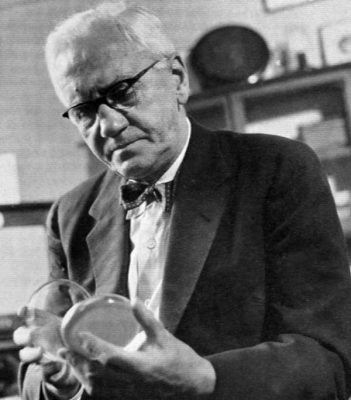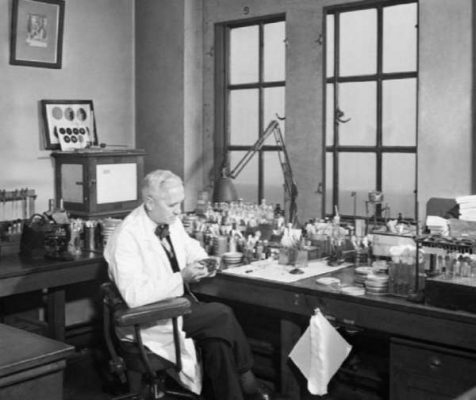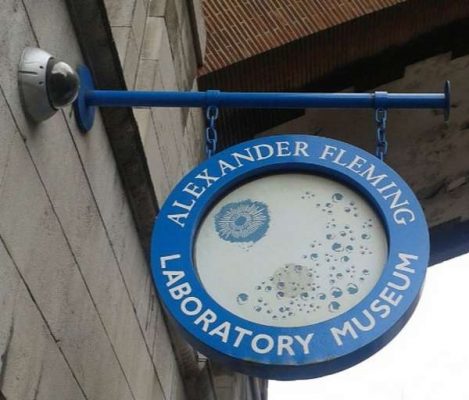Alexander Fleming was a Scottish biologist and botanist. He is famous for his remarkable discoveries of lysozyme (which is an enzyme) and antibiotic (Penicillin G). In recognition of his services in the field of medicine, he was awarded Nobel Prize in Physiology along with Ernst Boris Chain and Howard Florey. He did a lot of work in bacteriology and immunology.
Early Life
- He was born on 6 August, 1881 in the southwest county of Scotland, Ayrshire.
- His parents were farmers.
- The nickname of Alexander was ‘Alex’. He was only seven when his father passed away.
- He gained a scholarship for two years to Kilmarnock Academy. After this, he went to Royal Polytechnic Institution in London.
- Tom was his elder brother and he persuaded him to join the medical career. As per his brother’s advice, Fleming went to Paddington and took admission in St Mary’s Hospital Medical School. He achieved distinction in his MBBS degree.
- In his medical school, he became assistant bacteriologist to a British bacteriologist known as Almroth Wright.
- He earned a Gold Medal in B.Sc. in bacteriology in 1908. Thereafter, he started giving lectures in the same school for another 6 years.
- During World War I, he served in the Royal Army Medical Corps at the rank of captain.

Achievements
- In WWI, Fleming saw many soldiers in the battlefield dying of sepsis. It’s a fatal medical condition in which the immune system of a body starts destroying its own organs resulting in death. He found out that antiseptics were destroying the immune system of a body instead of killing the bacteria that attacked the body. As a result, more and more soldiers were being killed due to antiseptics rather than infectious wounds.
- Fleming concluded from his findings that antiseptics did great damage in case of deep wounds. It is because deep wounds tend to give protection to the anaerobic bacteria and isolate the bacteria from the reach of antiseptics. This way, antiseptics kill bacteria that are on the surface as well as other useful substances that are protecting the body.
- Despite his findings, the doctors at the time kept on using antiseptics on the wounded soldiers and did not pay attention to Fleming’s advice.
- It was Fleming who discovered lysozyme for the first time. It is basically an enzyme which is found in the human secretions of saliva, tears and mucus. While testing a mucus of a patient suffering from severe cold, he deduced that nasal mucus tend to block the growth of bacteria. Thus, he discovered it.
I certainly didn’t plan to revolutionize all medicine by discovering the world’s first antibiotic, or bacteria killer, but I suppose that was exactly what I did – Fleming
- The laboratory in which Fleming used to do research was often very dirty.
- In 1927, Fleming was doing research on gram-positive bacteria called staphylococci.
- The discovery of Penicillin was accidental. In August 1928, Fleming had left his laboratory and joined his family for vacations. He had stacked cultures of staphylococci in his lab’s corner before going out. But on his return, he found something weird which he called “That’s funny”. He noticed the fungus had contaminated one of the cultures of staphylococci. The colonies of staphylococci present close to the fungus were eradicated while colonies that were located far off, had remained safe and normal. He then allowed a pure culture of staphylococci to grow mould (grey substance that is grown on food lying in open air for a long time) and found that mould tend to produce a substance which kills the gram-positive bacteria.
- Fleming found this mould to have come from genus Penicillium. Later on, he used to name it as ‘mould juice’.
- On 7 March, 1929, Fleming called this substance which the mould releases as penicillin.
- The laboratory of St. Mary’s Hospital in which Fleming discovered penicillin is now turned into a museum in London. It is named after him.
- Fleming investigated that penicillin could destroy Gram-positive bacteria which cause diseases like scarlet fever, meningitis and pneumonia. However, it was not effective against Gram-negative bacteria which cause typhoid fever.
- Through his findings, Fleming concluded that it was not easy to separate antibiotic agent from the mould. Eventually, he came to a conclusion that this substance could be produced in great quantity and its action against infections is also very slow. By then, he was certain that penicillin may not remain inside the body for a long time to destroy the invading bacteria because tests had proved unsuccessful. After sometime, he decided to discontinue doing research on penicillin. After Fleming had left, Florey and Chain took up the challenge to produce penicillin in mass quantities.
- The discovery of penicillin by Fleming laid the foundation of modern antibiotics. It saved millions of lives all over the world.

Honors
- Today, the Royal Polytechnic Institution has turned into University of Westminster. One of the halls of student residence in this university is named after Fleming.
- In Madrid, a sculptor of Fleming is situated outside the bullring of Las Ventas.
- One of the asteroids located within the Asteroid Belt is named after Alexander Fleming.
- In 1944, Fleming was knighted. A year before, he became a Fellow of the Royal Society (FRS).
- He was one of the Time magazine’s 100 Most Important People of the 20th Century in 1999.
- On March 11, 1955, Fleming suffered a fatal heart attack in London and passed away. His grave is in St Paul’s Cathedral.

Leave a Reply